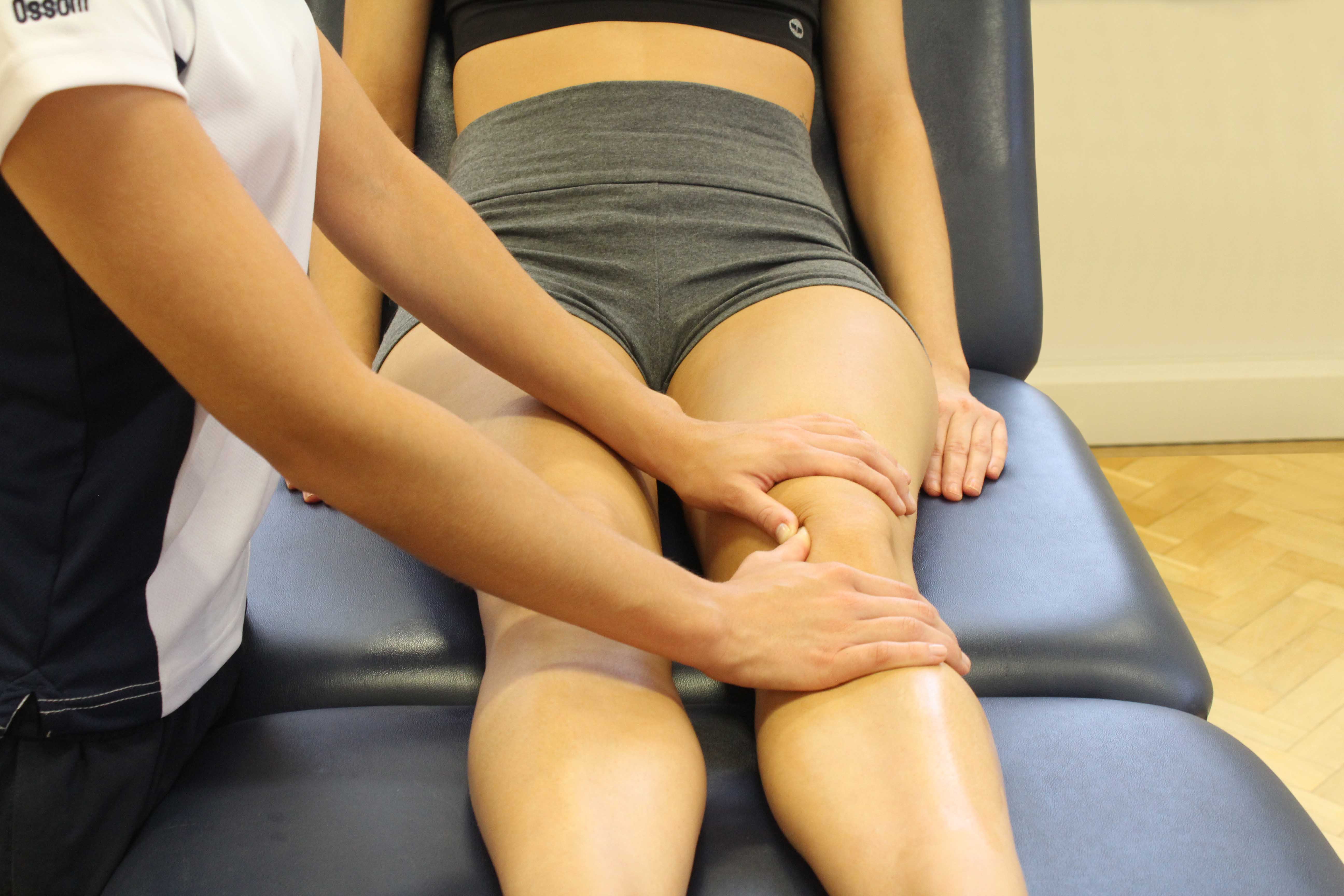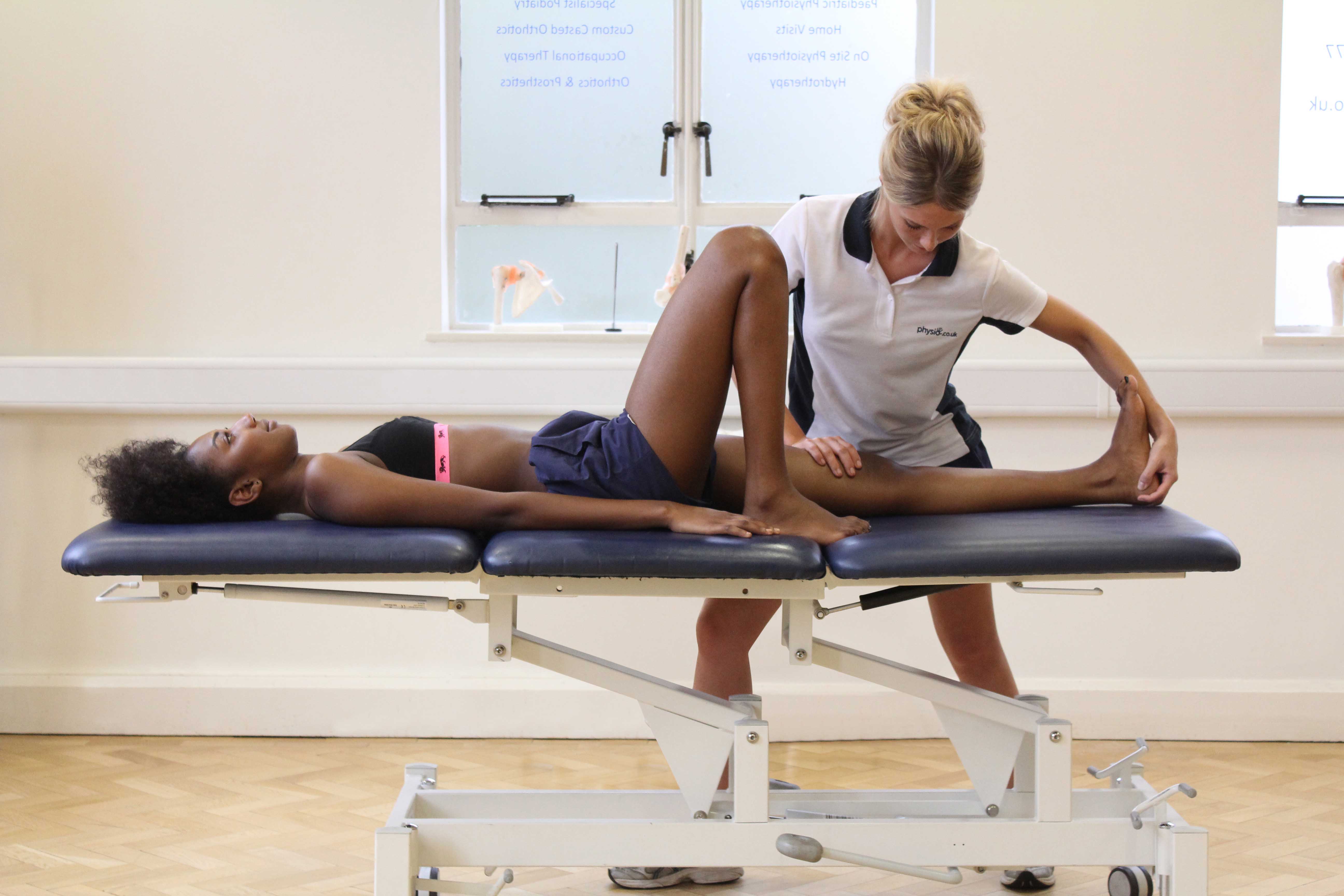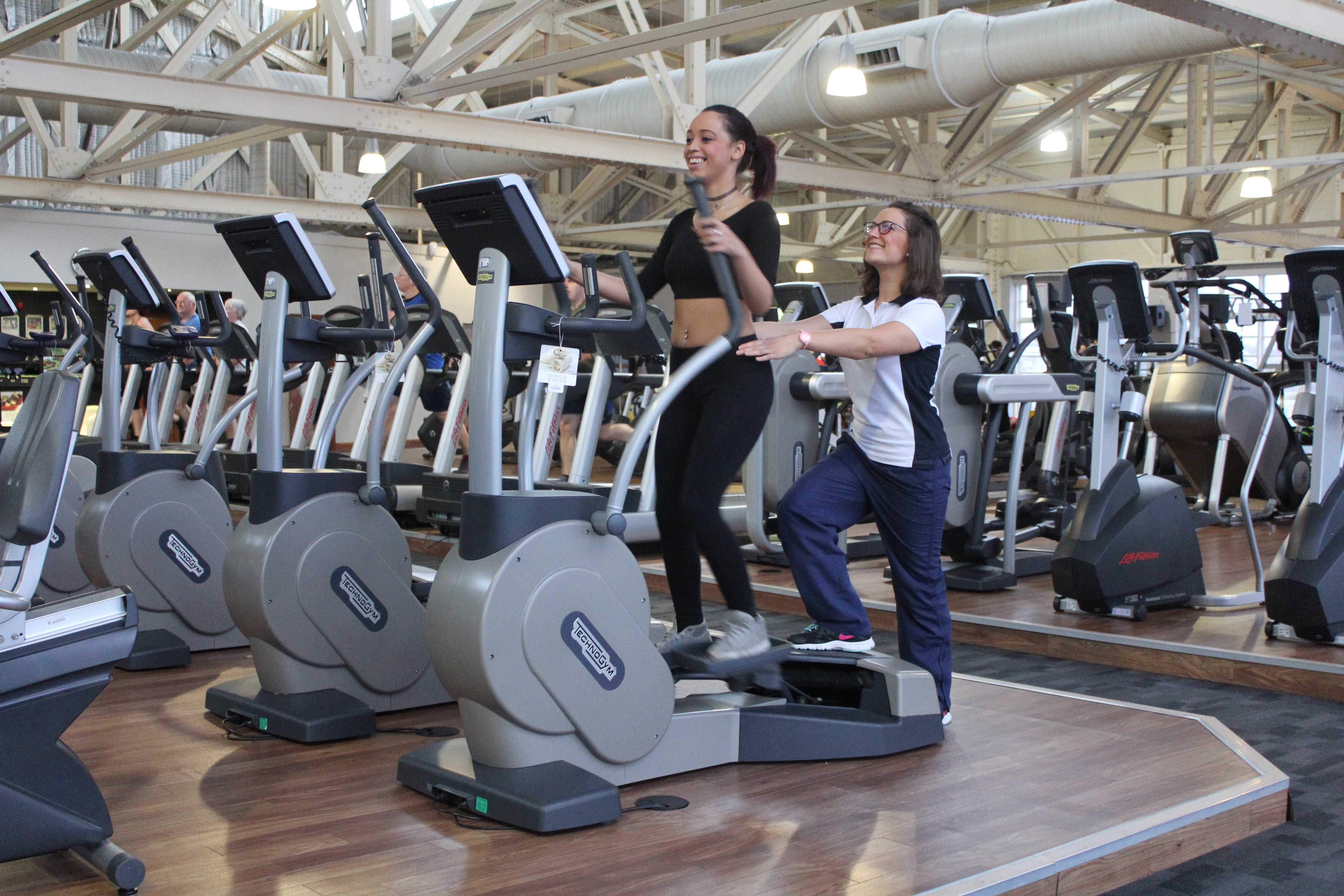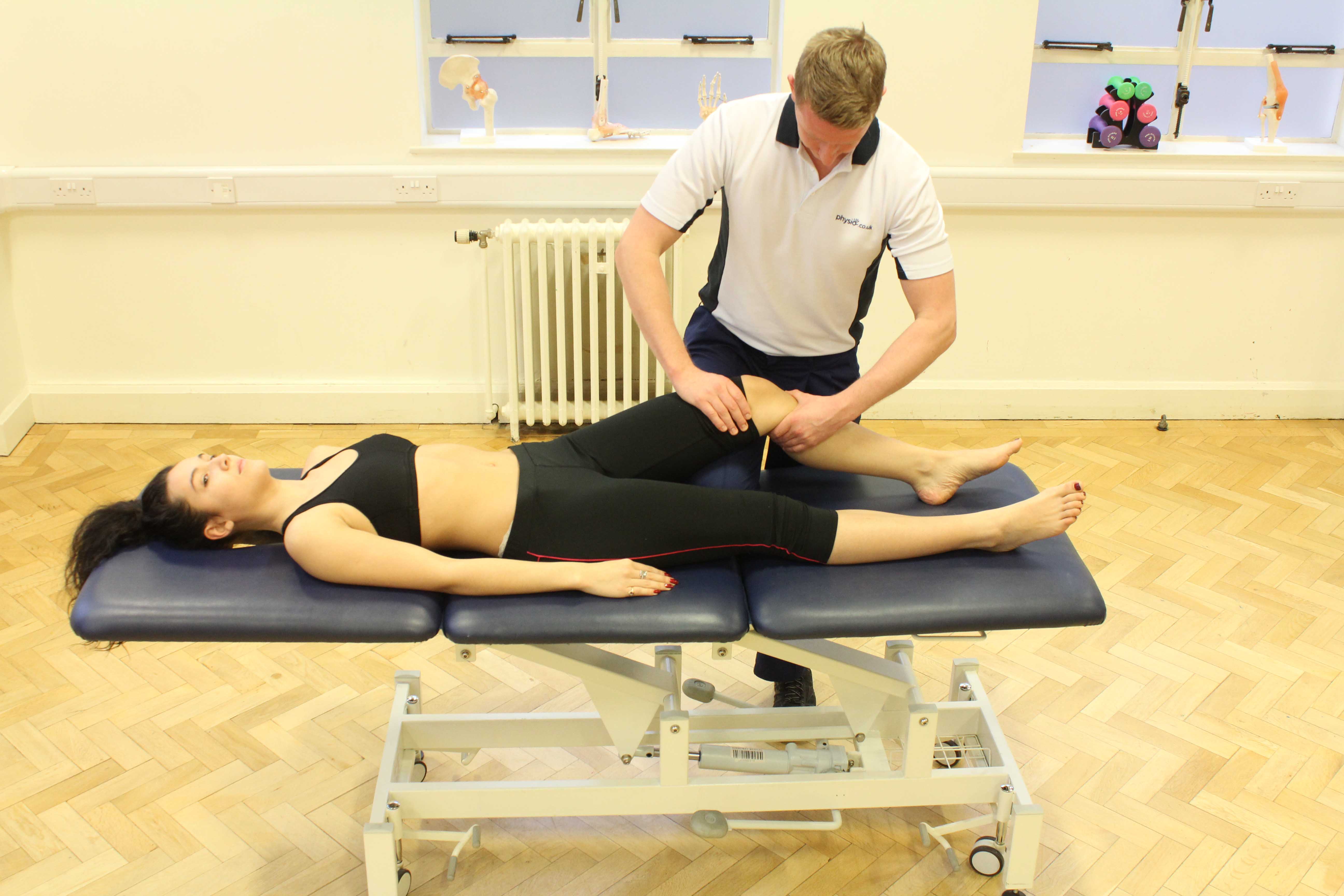Patella Stabilisation / Realignment Surgery
Patella stabilisation surgery also known as patella realignment is a surgical procedure to stabilise and realign the patella following subluxation, dislocation and subsequent misalignment of the knee cap during movements. Physiotherapy plays a crucial role in rehabilitation and recovery following patella stabilisationsurgery.
The patella (kneecap) is a small, floating, sesamoid bone located at the front of the knee. The patella is one of three bones along with the thigh bone (femur) and shin bone (tibia) that make up the knee joint. The patella is embedded in the quadriceps tendon at the front of the knee and functions as a pulley for the quadriceps to help create more power during movements of the knee.
Patella stabilisation is a surgical procedure used in the treatment of conditions such as patella subluxation and patella dislocation.
 Above: Patella mobilisations performed by MSK Physiotherapist
Above: Patella mobilisations performed by MSK PhysiotherapistPatella subluxation
In a normal knee, the patella glides up and down within a groove at the bottom of the thigh bone (femoral groove or trochlea) during movement. Weakening of the muscles that hold the patella in its correct position within the femoral groove causes instability of the kneecap. Instability can cause the patella to be pulled out of the femoral groove and towards the outer side of the knee known as patella subluxation. Patella subluxation causes maltracking of the patella resulting in significant discomfort and irritation at the front of the knee during knee movements.
 Above: Mobilisations of the knee joint during an assessment by a MSK therapist
Above: Mobilisations of the knee joint during an assessment by a MSK therapistPatella dislocation
A dislocation of the patella occurs when the knee cap comes completely out of its groove and rests on the outside of the knee joint. Kneecap dislocation results from patella instability. Often, when the kneecap has dislocated for the first time, ligaments that were holding the kneecap in position are torn. The most common ligament that is torn as a result of knee dislocation is the medial patellofemoral ligament (MPFL). Knee dislocation and tearing of the MPFL causes the patella to be out of its correct position and therefore fails toglide up and down its femoral groove properly (maltracking). Maltracking of the patella causes a considerable amount of pain and irritation at the front of the knee during movement.
 Above: Strength training for the knee, supervised by a MSK Physiotherapist
Above: Strength training for the knee, supervised by a MSK PhysiotherapistPatella stabilisation surgery
Instability and subsequent maltracking of the patella can be treated in a number ways depending on the initial cause of the problem. For minor patella problems, conservative treatment such as physiotherapy is recommended. However, if patella instability is causing recurrent patella dislocations, significant patella pain, and instability or giving way of the knee then an appropriate surgical procedure will be required to stabilise the kneecap. Patella stabilisation surgery is done in a variety of ways including:
- Lateral release surgery
- Medial reefing
- Medial patellofemoral ligament (MPFL) repair
- Tibial tubercle transfer
 Above: Mobilisations of the knee joint by a MSK therapist
Above: Mobilisations of the knee joint by a MSK therapistLateral release
Lateral releaseis effective in treating patella subluxation, dislocation and misalignment. If the patella has moved out of its groove and towards the outer side of the knee joint, lateral release surgery is recommended to correct patella alignment and further stabilise the knee cap. Lateral release involves cutting the tight lateral tissues and muscles that have pulled the patella out of position, allowing the patella to resume its normal position.
Medial Reefing
When the patella (kneecap) tends to ride too far to the lateral (outer) side of the knee (lateral tracking or 'maltracking'), the surgeon may try to loosen the structures on the lateral side (lateral release) and tighten them on the medial (inner) side know as medial reefing.This is done arthroscopically (keyhole) using stitches (sutures) to hold the tightened medial structures in place. Lateral release and medial reefing may be done at the same time.
MPFL repair
Following kneecap dislocation, a tear to the medial patellofemoral ligament can increase the risk of further instability and recurrent dislocations. In this case, surgery is appropriate to repair and tighten the damaged medial patellofemoral ligament. The surgery involves anchoring the MPFL back onto the femur (thigh bone) where it was torn. The procedure may also involve overlapping tissue fibres to tighten the stabilising structures on the inside of the knee with the aim to maximise stability of the knee cap and consequently prevent further dislocations. MPFL repair may be done alongside lateral release in the pursuit of maximum stabilisation and correct alignment of the patella.
Tibial tubercle transfer
This operation involves surgically lifting up a part of bone from the front of the tibia (shin bone) upon which the patellar tendon is attached. The part of the bone is then swung inward (medially) and fixed solidly with pins or screws. The effect of this is to shift the line of muscle pull on the knee cap inward, resisting the tendency for the knee cap to dislocate outward.
The main goal of patella stabilisation surgery is to restore normal alignment and tracking of the patella during movements and therefore eliminate pain and irritation caused by patella instability and to prevent the likelihood of reccurring dislocation of the kneecap in the future. Physiotherapy after patella stabilisation surgery is crucial to ensure the success of the surgery, to prevent the likelihood of any problems occurring in the future and to guarantee the return of full and painless function in the knee joint.
Physiotherapy before patella stabilisation surgery
Before you have patella stabilisation surgery it is necessary to take part in a physiotherapy programme to better prepare your knee for the surgery and help guarantee a quick and successful recovery after you have had your operation. Physiotherapy prior to patella stabilisation also helps to prevent the likelihood of any problems occurring once you have had the surgery. Physio.co.uk will offer you a physiotherapy course that aims to strengthen the muscles in and around your knee as much as possible with specific attention on strengthening the muscles that are causing weakness and instability of the kneecap. Physio.co.uk will aim to strengthen the weak muscles on the inner part of your knee to help prevent recurrent dislocation on the outer side of the knee after surgery. Physiotherapy before your patella stabilisation surgery will also involve exercises to maintain your range of movement and increase your cardiovascular fitness to maximise the success of the surgery and your recovery afterwards.
Symptoms after patella stabilisation surgery
You will experience pain, stiffness and reduced range of movement in your knee joint for a short period of time after your patella stabilisation surgery. Following patella stabilisation surgery your knee will be in a long, hinged knee brace for approximately six weeks. In addition, you will be begin by partially weight bearing and may require elbow crutches at this time to maintain mobility before progressing to full weight bearing as tolerated. You will be unable to drive until you have full and painless range of movement in your knee after the surgery.
Physiotherapy after patella stabilisation surgery
Physiotherapy after patella stabilisation surgery is crucial to ensure the success of the surgery and to guarantee the return of full or near full function in your knee. Physio.co.uk will offer a comprehensive physiotherapy programme which aims to control pain and swelling, regain normal knee range of movement, regain a normal gait pattern (walking), regain normal proprioception (balance) and stability, improve lower extremity strength and return your knee to the level of function it was capable of prior to your knee problems. Depending on the rate of your recovery and the type of surgery you had, rehabilitation could take from 3 to 6 months.
0-4 weeks
During the initial stages after your patella stabilisation surgery your physiotherapy with Physio.co.uk will begin by focusing on reducing any pain and swelling that you will be experiencing in your knee. Your physiotherapy will aim to maintain your mobility and attempt to get you partially weight bearing followed by fully weight bearing as soon as possible after your surgery. At this stage, goals for your rehabilitation with Physio.co.uk also include maintaining range of movement and strength in the muscles in and around your knee. your physiotherapy will include:
- Cryotherapy (ice)
- Compression and elevation
- Pain modalities
- Passive (assisted) range of movement exercises
- Gentle patella mobilisations
- Strengthening exercises for VMO (vastus medialis oblique located on inner side of knee)
- Strengthening exercises for hamstring, hip flexors and calf muscles
- Stretching and flexibility exercises for all lower limb muscles
- Weight bearing exercises as tolerated
- Weight shifting and balance exercises (use of crutches in early stages)
- Hydrotherapy
4-8 weeks
After a month of successful rehabilitation, your physiotherapy programme with Physio.co.uk will continue to minimise any pain and swelling you may still be experiencing. Rehabilitation will now focus on building up the strength in the muscles in and around your knee while also increasing range of movement in your knee joint. To reinforce the goals of the surgery, Physio.co.uk will specifically focus on strengthening the muscles on the inner side of your knee (vastus medialis oblique) to maintain correct patella alignment and help prevent recurring kneecap dislocation. By this time you should be fully weight bearing therefore Physio.co.uk can now help retrain your gait and proprioception (balance).
- Cryotherapy (ice)
- Compression (knee brace)
- Patella mobilisations
- Passive and active range of movement exercises
- Strengthening exercises for quadriceps, hamstrings and calf muscles
- Strengthening exercises for muscles in hip, ankle and opposite limb
- Stretching and flexibility exercises for lower extremity
- Weight bearing activities as tolerated
- Gait re-education
- Proprioception (balance) training
- Hydrotherapy
8-12 weeks
After 8 weeks with Physio.co.uk you will now be fully weight bearing and will have full and painless range of movement in your knee. Your physiotherapy will now focus on the continuation of strengthening exercises for the muscles in and around your affected knee as well as your hip, ankle and opposite leg for further support. Physio.co.uk will continue to include range of movement exercises, gait re-education, proprioception (balance) training and muscle control exercises. Additionally, your physiotherapy will continue to focus on specific exercises that aim to strengthen your vastus medialis oblique muscle(VMO) and medial patellofemoral ligament (MPFL). Now that you will have made progress in each of these activities, you will be encouraged to take part in exercises that improve your cardiovascular fitness and muscle endurance that will further prevent any recurring problems with your knee joint and will help maximise your recovery. Your physiotherapy will include:
- Continuation of strengthening exercises from previous weeks
- Continuation of stretching exercises from previous weeks
- Patella mobilisations
- Active range of movement exercises
- Gait re-education
- Proprioception (balance) training
- Static bicycle (resistance as tolerated)
- Hydrotherapy
- Walking
3 months onwards
After your patellar stabilisation surgery and once you have undergone 12 weeks of successful rehabilitation with Physio.co.uk you will have made significant improvements in the strength of the muscles in and around your knee. Additionally, you will have regained full range of movement as well as considerably increased your cardiovascular fitness. At this stage, you will not be feeling any pain during movement in your knee. The goals of your physiotherapy programme will continue to focus on preventing future problems involvingthe weakening of the structures around your kneecap that could consequently result in recurrent dislocation or subluxation. Furthermore, 3 months after you patella stabilisation surgery, your rehabilitation with Physio.co.uk will now gear towards exercises that are specific to your cardiovascular fitness, sport, hobby and everyday activities to make sure you get back to what you love doing the most as soon as it is physically possible.
Full recovery after patella stabilisation / realignment surgery may take up to 6 months. The success and rate of your recovery highly depends on your commitment and adherence to the comprehensive physiotherapy programme provided by Physio.co.uk as well as the initial condition of your knee prior to your surgery.
Summary
Patella stabilisation / realignment surgery is a surgical procedureto correct or improve abnormal patellar tracking, and improve kneecap stability. Patella stabilisation surgery is required if the kneecap is out of its correct positionor has dislocated as a result of weakened muscles, tissues or ligaments around the kneecap. Patella stabilisation or realignment surgery can alleviate symptoms such as pain, stiffness and irritation caused by maltracking of the kneecap during movement. Patella stabilisation can be achieved with a number of surgical procedures. Most common procedures include lateral release, medial reefing, medial patellofemoral ligament repair and tibial tuberosity transfer. The main aim of patella stabilisation surgery is to restore normal tracking of the patella and offer you a painless and fully functional knee. Physiotherapy after patella stabilisation surgery is essential to maximise the success of the surgery, prevent further dislocations of instability associated with the kneecap and ensure the return of full or near to full function of your knee. Physio.co.uk offers a personal and comprehensive physiotherapy programme that will guarantee the successful and rapid recovery of your knee joint and get you back doing whatever it is you love doing the most whether it is your job, hobby or sport! Call Physio.co.uk now on 0330 088 7800 for more information or contact us to book an appointment.

 0330 088 7800
0330 088 7800





































